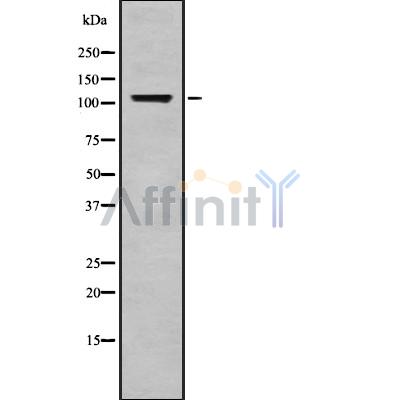Basonuclin Antibody - #DF8812
| Product: | Basonuclin Antibody |
| Catalog: | DF8812 |
| Description: | Rabbit polyclonal antibody to Basonuclin |
| Application: | WB IHC |
| Reactivity: | Human |
| Prediction: | Pig, Zebrafish, Bovine, Horse, Sheep, Rabbit, Dog, Chicken, Xenopus |
| Mol.Wt.: | 111 kDa; 111kD(Calculated). |
| Uniprot: | Q01954 |
| RRID: | AB_2842009 |
Related Downloads
Protocols
Product Info
*The optimal dilutions should be determined by the end user. For optimal experimental results, antibody reuse is not recommended.
*Tips:
WB: For western blot detection of denatured protein samples. IHC: For immunohistochemical detection of paraffin sections (IHC-p) or frozen sections (IHC-f) of tissue samples. IF/ICC: For immunofluorescence detection of cell samples. ELISA(peptide): For ELISA detection of antigenic peptide.
Cite Format: Affinity Biosciences Cat# DF8812, RRID:AB_2842009.
Fold/Unfold
AI047752; AW546376; basonuclin 1; BNC; Bnc1; BNC1_HUMAN; BSN1; HsT19447; zinc finger protein basonuclin; Zinc finger protein basonuclin-1;
Immunogens
A synthesized peptide derived from human Basonuclin, corresponding to a region within the internal amino acids.
In epidermis, primarily detected in cells of the basal or immediately suprabasal layers (at protein level) (PubMed:16891417). In hair follicles, mainly expressed in the outer root sheath (at protein level) (PubMed:8034748). Expressed in epidermis, testis and foreskin, and to a lower extent in thymus, spleen, mammary glands, placenta, brain and heart (PubMed:9687312).
- Q01954 BNC1_HUMAN:
- Protein BLAST With
- NCBI/
- ExPASy/
- Uniprot
MRRRPPSRGGRGAARARETRRQPRHRSGRRMAEAISCTLNCSCQSFKPGKINHRQCDQCKHGWVAHALSKLRIPPMYPTSQVEIVQSNVVFDISSLMLYGTQAIPVRLKILLDRLFSVLKQDEVLQILHALDWTLQDYIRGYVLQDASGKVLDHWSIMTSEEEVATLQQFLRFGETKSIVELMAIQEKEEQSIIIPPSTANVDIRAFIESCSHRSSSLPTPVDKGNPSSIHPFENLISNMTFMLPFQFFNPLPPALIGSLPEQYMLEQGHDQSQDPKQEVHGPFPDSSFLTSSSTPFQVEKDQCLNCPDAITKKEDSTHLSDSSSYNIVTKFERTQLSPEAKVKPERNSLGTKKGRVFCTACEKTFYDKGTLKIHYNAVHLKIKHKCTIEGCNMVFSSLRSRNRHSANPNPRLHMPMNRNNRDKDLRNSLNLASSENYKCPGFTVTSPDCRPPPSYPGSGEDSKGQPAFPNIGQNGVLFPNLKTVQPVLPFYRSPATPAEVANTPGILPSLPLLSSSIPEQLISNEMPFDALPKKKSRKSSMPIKIEKEAVEIANEKRHNLSSDEDMPLQVVSEDEQEACSPQSHRVSEEQHVQSGGLGKPFPEGERPCHRESVIESSGAISQTPEQATHNSERETEQTPALIMVPREVEDGGHEHYFTPGMEPQVPFSDYMELQQRLLAGGLFSALSNRGMAFPCLEDSKELEHVGQHALARQIEENRFQCDICKKTFKNACSVKIHHKNMHVKEMHTCTVEGCNATFPSRRSRDRHSSNLNLHQKALSQEALESSEDHFRAAYLLKDVAKEAYQDVAFTQQASQTSVIFKGTSRMGSLVYPITQVHSASLESYNSGPLSEGTILDLSTTSSMKSESSSHSSWDSDGVSEEGTVLMEDSDGNCEGSSLVPGEDEYPICVLMEKADQSLASLPSGLPITCHLCQKTYSNKGTFRAHYKTVHLRQLHKCKVPGCNTMFSSVRSRNRHSQNPNLHKSLASSPSHLQ
Predictions
Score>80(red) has high confidence and is suggested to be used for WB detection. *The prediction model is mainly based on the alignment of immunogen sequences, the results are for reference only, not as the basis of quality assurance.
High(score>80) Medium(80>score>50) Low(score<50) No confidence
Research Backgrounds
Transcriptional activator (By similarity). Likely specific for squamous epithelium and for the constituent keratinocytes at a stage either prior to or at the very beginning of terminal differentiation. Required for the maintenance of spermatogenesis (By similarity). May also play a role in the differentiation of oocytes and the early development of embryos (By similarity).
Phosphorylation on Ser-537 and Ser-541 leads to cytoplasmic localization.
Nucleus. Cytoplasm. Nucleus>Nucleoplasm.
Note: Relocates to the midpiece of the flagellum during late spermiogenesis in spermatids.
In epidermis, primarily detected in cells of the basal or immediately suprabasal layers (at protein level). In hair follicles, mainly expressed in the outer root sheath (at protein level). Expressed in epidermis, testis and foreskin, and to a lower extent in thymus, spleen, mammary glands, placenta, brain and heart.
Restrictive clause
Affinity Biosciences tests all products strictly. Citations are provided as a resource for additional applications that have not been validated by Affinity Biosciences. Please choose the appropriate format for each application and consult Materials and Methods sections for additional details about the use of any product in these publications.
For Research Use Only.
Not for use in diagnostic or therapeutic procedures. Not for resale. Not for distribution without written consent. Affinity Biosciences will not be held responsible for patent infringement or other violations that may occur with the use of our products. Affinity Biosciences, Affinity Biosciences Logo and all other trademarks are the property of Affinity Biosciences LTD.

